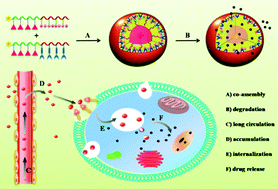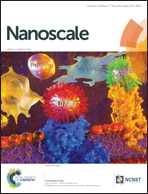Hierarchical design of a polymeric nanovehicle for efficient tumor regression and imaging†
Abstract
Effective delivery of therapeutics to disease sites significantly contributes to drug efficacy, toxicity and clearance. Here we designed a hierarchical polymeric nanoparticle structure for anti-cancer chemotherapy delivery by utilizing state-of-the-art polymer chemistry and co-assembly techniques. This novel structural design combines the most desired merits for drug delivery in a single particle, including a long in vivo circulation time, inhibited non-specific cell uptake, enhanced tumor cell internalization, pH-controlled drug release and simultaneous imaging. This co-assembled nanoparticle showed exceptional stability in complex biological media. Benefiting from the synergistic effects of zwitterionic and multivalent galactose polymers, drug-loaded nanoparticles were selectively internalized by cancer cells rather than normal tissue cells. In addition, the pH-responsive core retained their cargo within their polymeric coating through hydrophobic interaction and released it under slightly acidic conditions. In vivo pharmacokinetic studies in mice showed minimal uptake of nanoparticles by the mononuclear phagocyte system and excellent blood circulation half-lives of 14.4 h. As a result, tumor growth was completely inhibited and no damage was observed for normal organ tissues. This newly developed drug nanovehicle has great potential in cancer therapy, and the hierarchical design principle should provide valuable information for the development of the next generation of drug delivery systems.



 Please wait while we load your content...
Please wait while we load your content...